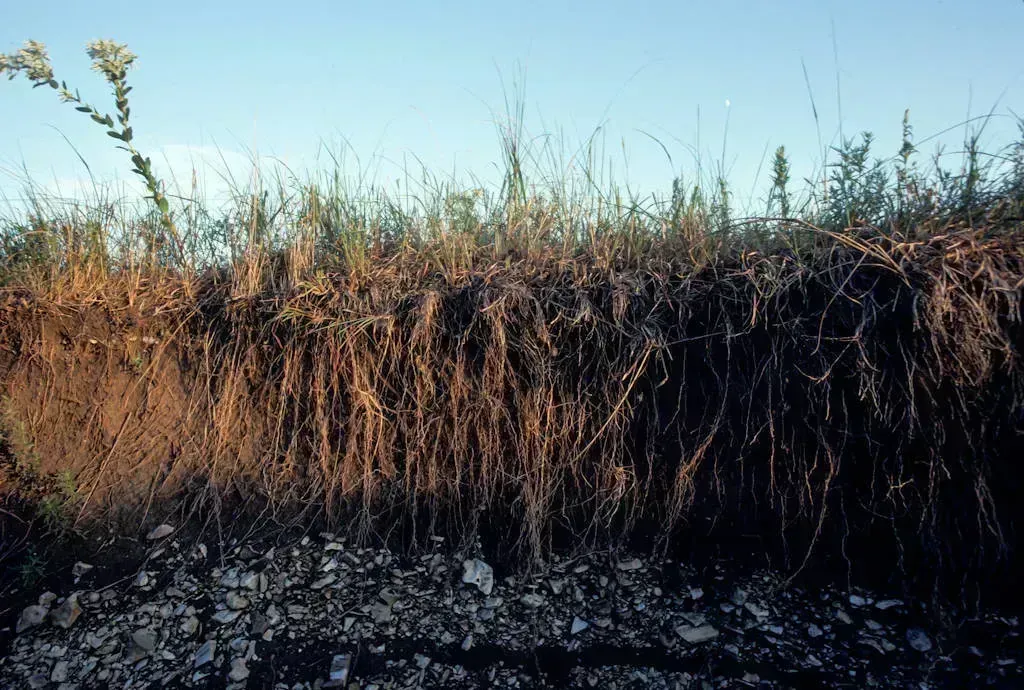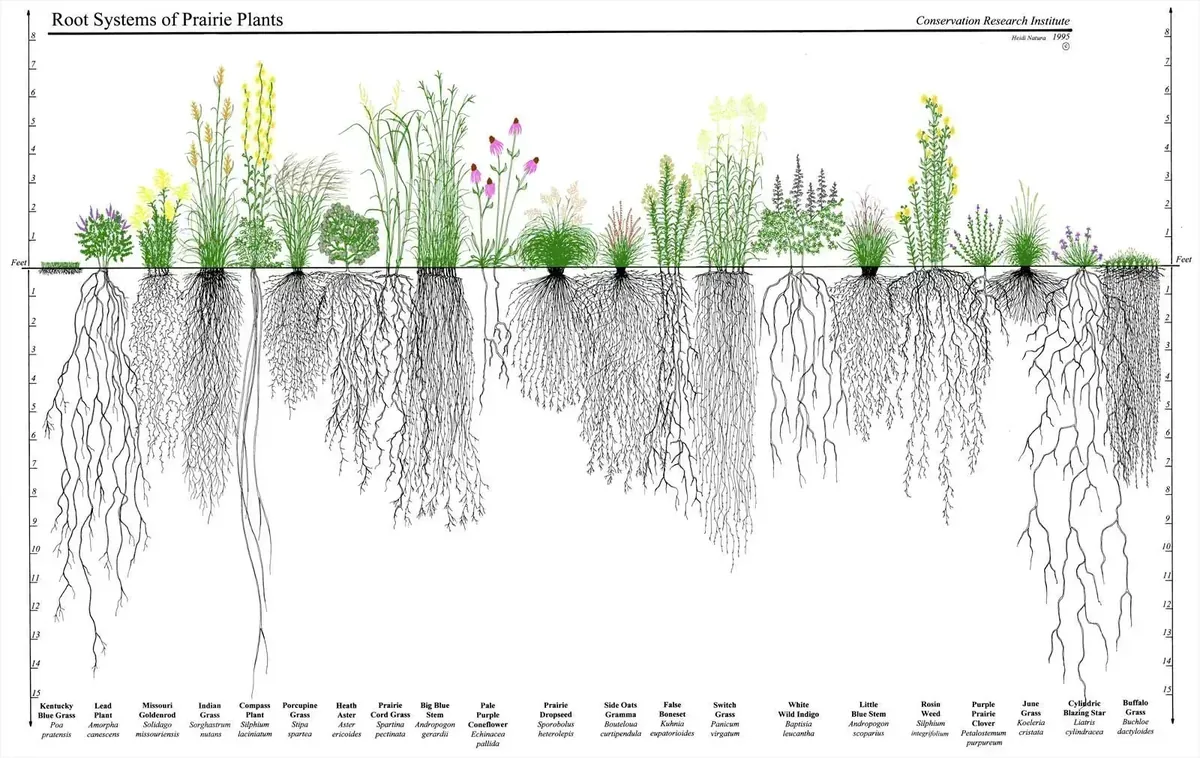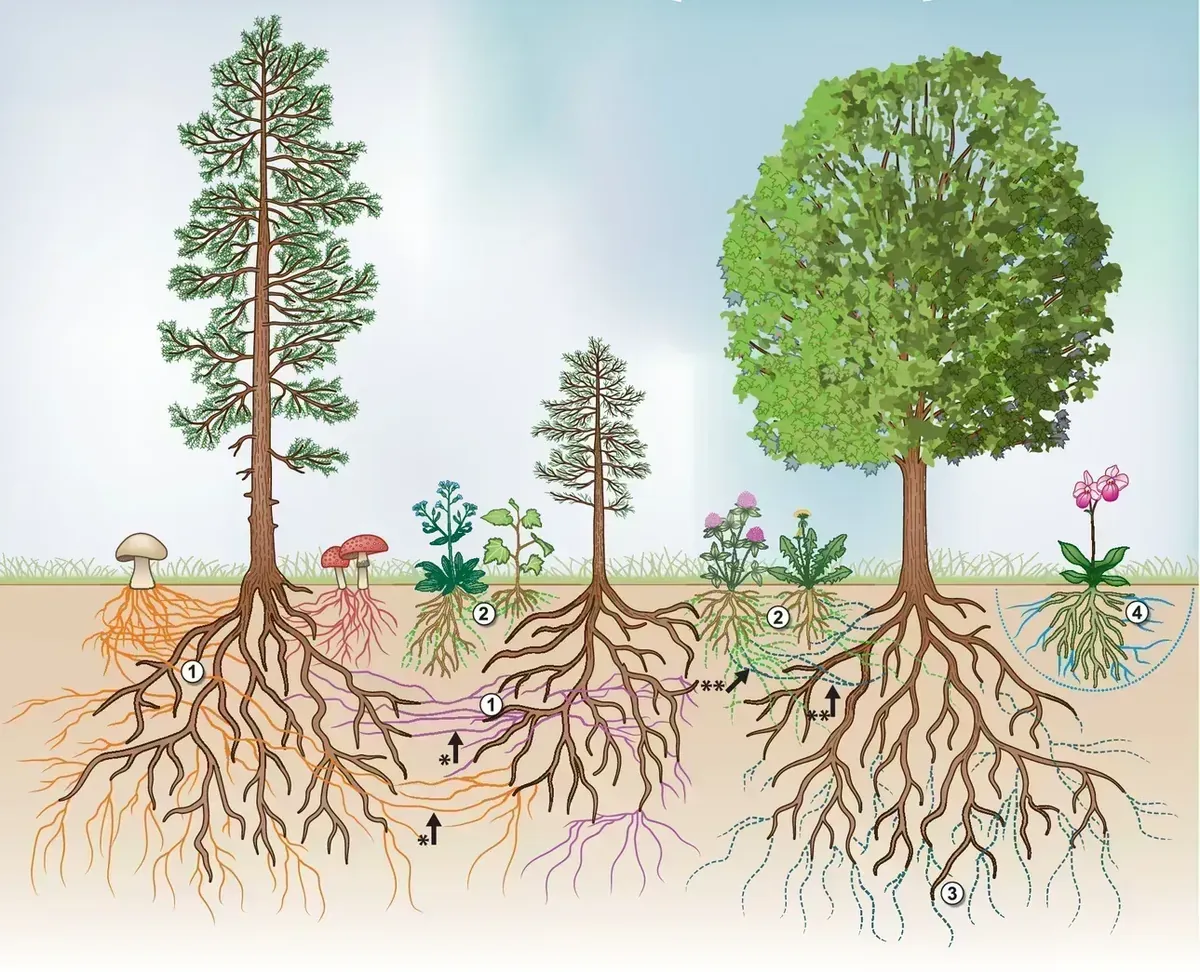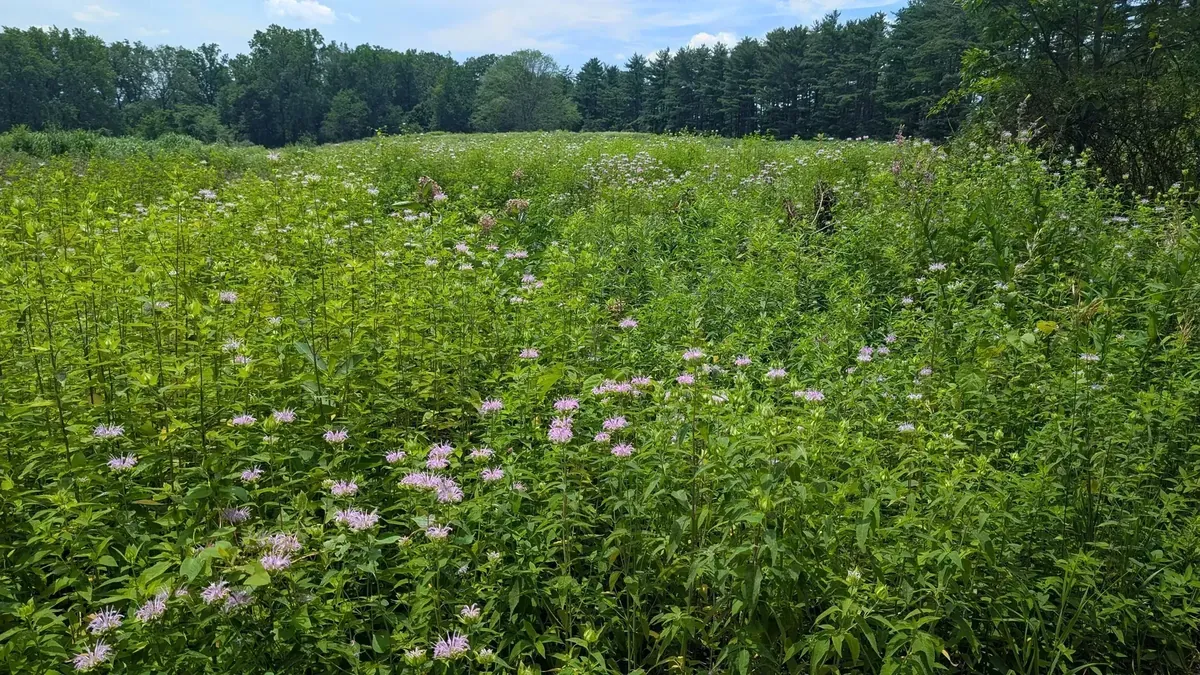Standing in a Pennsylvania meadow on a summer morning, you see what appears to be nature’s simplicity—gentle waves of green grass swaying in the breeze, punctuated by wildflowers and the occasional butterfly. But beneath your feet lies one of Earth’s most sophisticated ecosystems, where plants engage in chemical warfare, forge underground alliances spanning miles, and engineer their environment with precision that rivals any human technology.
The ordinary-looking grasses surrounding you are actually master architects, spending nearly half their energy to construct invisible underground cities. These “simple” plants maintain chemical communication networks, manipulate soil microbes through targeted signals, and store more carbon than most forests. What you’re witnessing is the result of millions of years of evolutionary engineering, thousands of years of landscape management, and ecological partnerships so complex that scientists are only beginning to understand them.
The underground cities beneath your feet
Walk through any Pennsylvania meadow and you’re treading above an underground metropolis that dwarfs anything visible on the surface. For every foot of grass reaching skyward, there are roughly 5 feet of roots plunging deep into the earth—sometimes extending down to a basement’s depth. Yet most water uptake actually occurs near the surface (See A Deep-Rooted Prairie Myth - Prairie Ecologist). These massive root systems serve as underground construction crews, building soil structure that prevents flooding and erosion while creating the foundation for all terrestrial life.
For every blade of grass you see, there are roughly 4 times more plant material hidden underground. It’s like seeing just the tip of an iceberg—most of the action is happening where you can’t see it. This hidden infrastructure is what makes grasslands so resilient to drought, storms, and other disturbances that devastate shallower-rooted vegetation.
But the real architectural marvel happens when these roots partner with beneficial soil fungi. Recent research analyzing 2,296 field sites worldwide shows that mycorrhizal fungi enhance soil organic carbon storage by up to 21.5% through plant diversity mechanisms (Zhang et al., 2025, PNAS). These partnerships work like adding extra arms to every root, extending their reach by hundreds of times. This underground network is why patches of native grass often stay green during droughts when nearby lawns turn brown-they’re tapping into resources that shallow roots can’t reach.


The soil factory that feeds the world
Every grass plant you see is busy building soil—the foundation that all land life depends on. Healthy grassland soil means your basement stays dry during storms, your air stays cleaner, and food stays affordable. Grasslands function like underground carbon vaults, storing more carbon than many forests and helping stabilize our climate.
A groundbreaking 22-year study shows that restored high-diversity grasslands achieve 200% greater carbon storage rates than natural succession (Yang et al., 2019, Nature Communications). This happens because grass roots are constantly growing, dying, and regrowing-pumping organic matter deep into the soil where it stays locked away for decades. Each acre of restored grassland removes as much carbon dioxide from the atmosphere as taking a car off the road for a year.
The root zones around grasses become bustling microbial cities that create the rich, living soil where food crops thrive. Grasses actively recruit and “farm” specific bacteria and fungi that fight plant diseases, improve water absorption, and cycle nutrients efficiently. Farmers near healthy grasslands often see better crop yields and fewer pest problems-the benefits spread beyond the meadow itself.
However, Pennsylvania-specific research on soil carbon storage and mycorrhizal network function remains limited compared to Midwest and western grassland studies. The USDA NRCS Pennsylvania soil surveys provide valuable baseline data, but more long-term monitoring is needed to quantify these benefits across Pennsylvania’s diverse soil types and climate conditions.
Nature’s air conditioning system
Grasslands function as biological air conditioners that can make your summer afternoons more comfortable and your energy bills lower. Grass surfaces can reduce ground temperatures by over 30°F compared to pavement, creating cooling effects that extend far beyond the meadow itself. Walk, or more likely drive, from a parking lot into a meadow on a hot day and you’ll immediately feel the difference. See more about Heat Islands.
This natural cooling happens through the coordinated release of water vapor from leaf surfaces and soil. A healthy grassland maintains significantly higher humidity levels than bare ground, creating comfortable microclimates that reduce the need for air conditioning in nearby buildings. Cities with grassland patches consistently record lower temperatures and better air quality than those dominated by pavement.
The grass structure itself acts as a natural windbreak and noise buffer, reducing wind speeds at ground level while filtering dust and pollutants from the air you breathe. Restored Pennsylvania grasslands support over 1,500 individual animals from at least 15 mammal and snake species, along with over 70 bee species that pollinate both wild plants and food crops. These climate benefits create the conditions that allow this extraordinary biodiversity to flourish right in your backyard.
Ice age giants and controlled fires build your backyard
The grasses around you are survivors whose ancestors lived through ice ages and have been growing in Pennsylvania for thousands of years. Pennsylvania once had over 150,000 acres of grasslands-today, only about 640 acres remain. Understanding this history explains why restoring even small patches of native grassland can have outsized benefits for local wildlife and soil health.
These grasslands were originally created and maintained by massive ice age herbivores. For thousands of years before human arrival, mammoths, mastodons, and giant ground sloths shaped Pennsylvania’s landscape through their browsing and trampling. These elephant-sized animals ate so many trees and shrubs that they kept forests from taking over, creating the open spaces that hundreds of native plants and animals depended on. When you see a thriving meadow today, you’re looking at an echo of landscapes that fed and sheltered wildlife for thousands of years.
When these megaherbivores went extinct around 11,000 years ago, the role of landscape management gradually shifted to Native American communities. While indigenous grassland management through controlled burning is well-documented across North America, Pennsylvania-specific documentation remains limited and represents a critical research gap. Archaeological evidence and tribal consultation are needed to fully understand traditional land management practices specific to Pennsylvania’s ecosystems. We know that controlled fires were used to maintain open habitats across much of eastern North America, but formal partnerships with tribal nations are essential for documenting traditional ecological knowledge specific to Pennsylvania.
Modern land managers are rediscovering that traditional fire practices often work better than expensive mechanical treatments, with The Nature Conservancy’s prescribed burning programs treating over 1,300 acres in Pennsylvania in 2024 alone. (We’ll explore the fascinating science of fire management in our next article.)
Bringing back lost worlds
Pennsylvania conservation efforts are working to resurrect these lost ecosystems using both cutting-edge science and rediscovered traditional knowledge. The National Park Service’s Eastern Grassland Restoration initiative spans 35 parks and involves direct treatment of over 4,000 acres across the eastern United States, with significant projects in Pennsylvania. The Pennsylvania Watershed Initiative aims to plant 5,000 acres of meadows by 2025, creating immediate benefits for surrounding communities-reducing flood risk, improving water quality, and providing natural spaces for recreation and education.
The results exceed expectations. Diverse restoration projects show 40% increases in native plant cover within three years, while supporting dramatically higher biodiversity than single-species plantings. Property values near restored grasslands often increase as these natural areas provide flood protection, noise reduction, and scenic beauty that concrete infrastructure cannot match.
However, comprehensive review of grassland soil carbon sequestration research reveals significant challenges and opportunities (Bai & Cotrufo, 2022, Science). Pennsylvania’s diverse soil types and climate conditions require region-specific research to optimize restoration practices for maximum carbon storage and ecosystem benefits.
This is important, because sadly we did lose a lot of these beautiful spaces. See more at Map For Grassland - Cornell - Cornell University.

*Grassland loss in the Northeast: 1992 vs. 2024, according to Cornell University. Source: Map For Grassland - Cornell
The beautiful web that connects it all
The next time you walk through a Pennsylvania meadow, you’re witnessing one of nature’s most elegant symphonies. The deep roots that survived ice ages are chatting with soil bacteria through chemical signals, and trading carbon over networks of fungal partners that extend across the entire meadow. The ice age giants that once shaped this landscape live on in the plant communities their browsing created. Traditional management practices that maintained these grasslands echo in the restoration burns happening today.
Every part supports every other part. The underground networks that help plants share resources also build the soil that cools your summer afternoons. The same root systems that prevent your basement from flooding create the carbon storage that helps stabilize climate. The plant communication networks that help grasses survive drought also create the diverse habitats where hundreds of species thrive.

This isn’t just an ecosystem-it’s a living testament to how beautiful the world becomes when everything works together. The grasses don’t just grow in the soil; they create it, share it, and improve it for the next generation. They don’t just survive in their environment; they actively engineer it to support the intricate web of life that makes a meadow more than just a collection of plants.
Understanding these connections doesn’t diminish the magic-it reveals a deeper beauty. Every step you take crosses thousands of miles of underground conversations, partnerships forged across millennia, and collaborative relationships that make the whole system more resilient, more productive, and more alive than any single part could be alone. The simple grass beneath your feet is actually a master class in how to build a world where everything flourishes together.
🔎 More Hidden Systems
If this fascinated you, explore other stories from The Hidden Systems that reveal the invisible infrastructures shaping our world:
🌼 Golden Highways — How roadside “weeds” create continental wildlife corridors.
And more to come. Each reveals a hidden system that connects nature, technological innovation, and economic power-showing how invisible networks shape everything from ecosystem health to global commerce.
For your curiosity
Mossy Earth Native Habitat Project “Nature’s Best Hope” by Douglas W. Tallany “The Hidden Life of Trees” by Peter Wohlleben - Discover how forest ecosystems communicate and cooperate Native Plant Identification Guide for Pennsylvania - Learn to identify the grasses and wildflowers around you Home Grown National Park
Sources
Primary Research Citations: Zhang et al. (2025) PNAS: Mycorrhizal Fungi Enhance Soil Organic Carbon Storage - Large-scale analysis of 2,296 field sites demonstrating enhanced carbon storage through plant diversity mechanisms
Yang et al. (2019) Nature Communications: Soil Carbon Sequestration Accelerated by Restoration of Grassland Biodiversity - 22-year study on restored high-diversity grasslands
Bai & Cotrufo (2022) Science: Grassland Soil Carbon Sequestration Challenges and Solutions - Comprehensive review of grassland carbon storage research
Government and Extension Sources: USDA NRCS Web Soil Survey - Pennsylvania - Pennsylvania-specific soil data and carbon storage information
National Park Service Eastern Grassland Restoration Initiative - Large-scale restoration across 35 parks
Penn State Extension: Meadows and Prairies - Pennsylvania-specific grassland restoration guidelines
Carbon Sequestration in Grasslands - Minnesota Board of Water & Soil Resources
Warm-Season Grasses and Wildlife - Penn State Extension
Piedmont Spotlight: Grasslands, Meadows, and Savannas - Brandywine Conservancy
Indigenous Fire Practices Shape our Land - National Park Service
Taking a Restoration Road Trip - The Nature Conservancy
Grassland a disappearing ecosystem - NWF Blog
Map For Grassland - Cornell - Cornell University
Investigating the transfer of carbon between trees via common mycorrhizal networks - T. D. Peters, D. L. Jones, A. R. Smith
Digging Deep Reveals the Intricate World of Roots - National Geographic
Still curious?
Want more fascinating explanations about the Secret Engines of the world? Subscribe to the RSS Feed.
